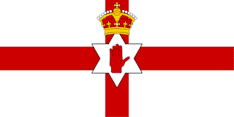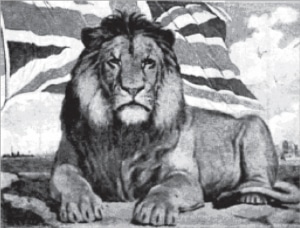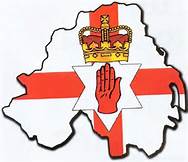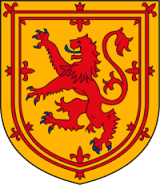THE TRUE ROOTS AND ORIGIN OF THE SCOTS – (5)
A research summary and pointers toward further research
“Wherever the pilgrim turns his feet, he finds Scotsmen in the forefront of civilization and letters. They are the premiers in every colony, professors in every university, teachers, editors, lawyers, engineers and merchants – everything, and always at the front.” – English writer Sir Walter Besant
“The mystery of Keltic: thought has been the despair of generations of philosophers and aesthetes …He who approaches it must, I feel, not alone be of the ancient stock … but he must also have heard since childhood the deep and repeated call of ancestral voices urging him to the task of the exploration of the mysteries of his people …He is like a man with a chest of treasure who has lost the key”
(The Mysteries of Britain by L Spence)
NATIONAL AND TRIBAL EMBLEMS
Symbols and heraldry are not taken lightly by specialists:
“Heraldry has been termed the Shorthand of History … [in Evans’ Grammar in Heraldry] ‘The antiquity of ensigns and symbols may be proved by reference to Holy Writ- ‘and they assembled all the congregation (of Israel) together on the first day of the second month, and they declared their pedigrees after their families, by the house of their fathers’ (Num. 1: 18) – ‘Every man of the children of Israel shall pitch by his own standard, with the ensign of their fathers house’ (Num. 2: 2).” … By the use of a certain coat of arms you assert your descent from the person to whom those arms were granted, confirmed or allowed. That is the beginning and end of armoury.”(38)
In other words a coat of arms must prove its historical validity to one of the Kings of Arms: Garter King at Arms (England); Lyon King at Arms (Scotland); Ulster King at Arms (northern Ireland). It is not some little thing, but an important aspect of national ethnic memory and roots.
The formidable lion- symbol of Judah
- Lion
The book of Genesis states the following about the future of Judah at that time:
“Judah, may your brothers praise you. May your hand be in the neck of your enemies. May your father’s sons bow before you [the royal line].
Judah is a lion’s whelp. My son, you have gone up from the prey. He stooped, he crouched like a lion; and like a lioness, who shall rouse him? [a warrior people] The scepter [the royal line] shall not depart from Judah, nor a Lawgiver [excellent administrators and developers of policy] from between his feet, until Shiloh come. And the obedience of the peoples to him.” (Gen 49:8-10)
Various lion symbols are rampant in Scotland and found in royal and family coats of arms, banners, flags and various emblems.
- Raised Red Right Hand
A tradition amongst the Ulster Scots is that their Right Hand symbol may find its genesis in the Bible:
“And it came to pass, when she travailed that the one put out his hand, and the midwife took and bound upon his hand a scarlet thread, saying “This came out first” And it came to pass, as he draw back his hand, that behold, his brother came out, and she said, “How hast thou broken forth? This breach be upon thee”. Therefore his name was called Pharez. And afterward came out his brother that had the scarlet thread upon ftis hand, and his name was called Zarah.” (Gen 38:28-30)
The Royal line was to continue through Judah, the fourth son of Jacob (Israel) (Gen 49:10). Christ Himself is a descendant of Pharez.
But Zarah left Egypt and founded colonies in Troy, Iberia next to the Colchis and in Iberia (Spain). Further information is contained in W. H. Bennett’s book Symbols of our Celto Saxon Heritage pages 110-114.
Due the descendants of Zarah being deprived of their prime status, they decided to migrate to out of the Near East to Europe, settling in Spain.
Later, the descendants of Zarah established the a kingdom on Ulster in the 17-15th century BC (the dates depend on which history one decides to accept).(39) Other members of the line of Pharez brought the other symbols with them including the harp, crown and six-pointed star.
The mythology of the Red Hand is a bit different, however. In this myth two giants were involved in a race from Scotland across the Irish Sea in a contest to possess Ulster. The winner, O’Neill, claimed victory by cutting off his hand and cast it on to the shore at Ulster. However, apparently this was a left hand and demonstrates how mythology can mix truth up.
But could the account in Genesis 38 be the true origin of the Red Hand of Ulster symbol?
What of the Scarlet Thread which runs through the British Naval Rope – is there a connection clear back to the Scarlet Thread of Zarah? Of further interest is that British official documents are tied with red ribbon (hence the term ‘red tape). In addition, the maps of the world showed the British Empire in red or pink and the British troops were known as red coats.
Further, the Coat of Arms of Northern Ireland contained a scarlet thread surrounding the Red Hand. But, in 1920 when the Home Rule Act incorporated the north-east in the United Kingdom of Great Britain and Northern Ireland, this thread no longer appeared around the hand. Possibly, this symbolises the union of Zarah and Pharez.
The famous uplifted red right hand is a clear symbol of Judah. A depiction of it may still be seen on one of the oldest Irish harps which have been preserved in Trinity College, Dublin.
What could be the derivation of this symbol? Clearly it is Biblical: it is a means to assert “I swear” as if in a covenant relationship. This symbol therefore is very good reminder of that Covenant with God through their ancestors.
“I will remember the years of the Right Hand of the Most High” (Ps 77:10)
“Thy Right Hand, O God, has become glorious in power” (Ex 15:6)
One of the best books on the subject of Biblical symbolism and typology is Dictionary of Biblical Imagery which explains that
“In social concourse, oaths and agreements were affirmed with the right hand (Gen 14:22; Ezek 17:18; Dan 12:7), expressions of fellowship were sealed with a right-handed handshake (Ezra 10:19), and giving and receiving were done with the right hand (Ps 26:10; Gal 2:9) …
“The right hand is the preferred one in patriarchal blessings (Gen 48:17-20); solemn oaths are made via the uplifted right hand (Is 62:8; Rev 10:5-7) … God’s right hand is said to be “filled with righteousness” (Ps 48:10) and effective might (Ps 80:15-16; 89:13). With his right hand he delivered Israel out of Egypt …”(40)
Christ is Himself at God’s right hand (Acts 2:33-34; Heb 1:3). No wonder, then, that the Ulster Scots use this symbol so powerfully, not willing to bow to the globalists or their rivals, the Church of Rome, or certain American millionaires.
In a sense Judah is also at God’s right hand because of their character and nature:
“Ephraim circles around Me with lying, and the house of Israel with deceit. But
Judah still rules with God, and is faithful with the saints.” (Hos 11:12)
In other words they still remember the covenant, at least to some degree. The Jews today still observe the Sabbath and the Scottish Presbyterians are also known as ‘covenanters’ who are social conservatives, Biblical literalists and lean strongly toward the Old Testament. From them, in the main, have sprung the school of theonomy and move toward Hebraic Biblical roots among many Protestants today.
In fact, the seventh-day Sabbath observance continued in Scotland for at least 1,000 years after it died out in other parts of Europe.
After the invention of the printing press, many common folk were able to have access to the Bible. In turn, religions thinkers such as Martin Luther arose who started the famous Protestant Reformation in 1517AD.
About 20 years later, John Calvin, a French Swiss, refined the philosophy of the Reformation and was joined by John Knox. Knox, a Scotsman. Knox took Calvin’s teachings back to Scotland from Geneva, Switzerland and before long Reformed communities arose in Scotland, England, Holland and France. After some circuitous adventures fleeing persecution, Knox organized the Presbyterian Church of Scotland. These are the roots of the Presbyterian Church.
Their view is similar to that of the Puritans when we come to the issue of their Sabbath: they observe their day strictly and attempt to utilise Old Testament scriptures to back up their claim that the Sabbath is still relevant and must be kept. In many ways, their exposition of the Sabbath is like Church of God material. But how unfortunate that they accept that the Sabbath is the seventh day, but transfer it to the first!
The Presbyterians have also figured prominently in American history. For example, Rev William Tennent founded a ministerial college that later evolved into Princeton University. Another was Rev John Witherspoon, one of the signaturees to the Declaration of Independence. Others were major influences in the Great Awakening of the 18th century.
To this day, the right hand is raised in when taking an oath in courts around the world.
- Coat of Arms and Banners
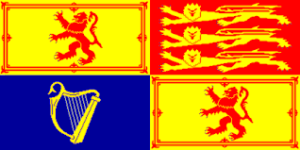 The Queen‘ s Royal Banner in Scotland
The Queen‘ s Royal Banner in Scotland
Another emblem is the Scottish banner which must be one of the prettiest one can observe. The banner is a golden flag with two unicorns. On the left of the flag is the banner of Scotland with a rampant lion with the flag staff supported by a unicorn. On the right you can find another unicorn supporting a flag staff with the flag of Saint Andrew (blue with a white cross). Each unicorn wears a crown on their heads and a golden cornet around their necks and golden chains attached, hanging down to the ground.
Between the two unicorns is a shield with a large red rampant lion. On top of the shield is a crowned knight’s helmet. Atop the helmet in turn is yet another lion – but instead of being in the rampant pose- is found holding the sceptre and sword. Next to this lion is the motto “In Defence”. It has been suggested that this lion represents Christ.
At the very bottom of the scroll a motto reads “No one attacks me with impunity”. You cannot get more Judaic than that!
Of further interest is how supportive of the Empire the Jews were. The Rothschilds Coat of Arms, for instance, includes the unicorn and lion prominently.
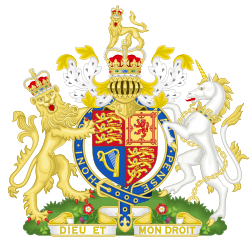 The Coat of Arms of Great Britain
The Coat of Arms of Great Britain
Note: the above British Coat of Arms is dominated by Judaic symbolisms. The lion of the tribe of Judah; young lions, harp of David; Zarah’s red thread; and the motto ‘God and my Right’, sometimes interpreted as meaning ‘God and my Birthright [of Ephraim]’ and/or ‘God and my right [to rule].”
Finally, we should not forget the famous Scottish Kilt. Prof lsserlin is a retired head of Semitic studies at Leeds University. lsserlin describes in a book the synthesis of ancient lsraelitish religion, culture, chronology and literature. In an amazing statement on page 98 he says:
“they wear their hair long, or a wig, and may be clean-shaven or bearded. Their dress may be long or short tunics or kilts, sometimes perhaps a short upper tunic above a long one.”(41)
An ancient inscription of Israelites wearing plaid kilts also appears on that page.
There are other national symbols that could be drawn upon, but the above should suffice for this purpose.
See also Appendices 6 and 7 for further information.
Footnotes
38 Scott-Davies 1972: 24, 6, 24
39 One theory suggests that the descendants of Zarah migrated out of the Near East under Calcol himself in the 17th century BC.
40 Ryken 1998: 729
41 lsserlin 1998: 98. Thanks to Susan Hermann for bringing this to my attention in an e-mail dated 28 August 2000.
End of part five – to be continued

